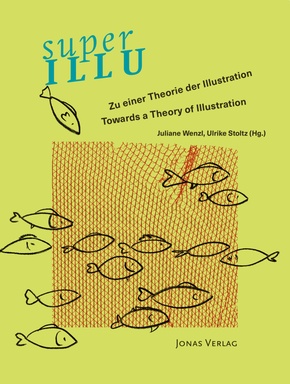superILLU - Zu einer Theorie der Illustration / Towards a Theory of Illustration
| Verlag | Jonas Verlag |
| Auflage | 2022 |
| Seiten | 352 |
| Format | 17,7 x 2,6 x 22,9 cm |
| Klappenbroschur | |
| Gewicht | 846 g |
| ISBN-10 | 3894455934 |
| ISBN-13 | 9783894455934 |
| Bestell-Nr | 89445593A |
'Illustration' zu definieren ist nicht einfach; immer sitzt sie zwischen den Stühlen der angewandten und freien Kunst, zwischen Dienstleistung und Selbstverwirklichungsanspruch. Mit neuen Möglichkeiten technischer Reproduzierbarkeit werden Illustrationen im 19. Jahrhundert einerseits omnipräsent und anderseits teilweise 'minderwertig'. Eine ähnliche Neubewertung erfahren sie heute im Kontext digitaler Reproduzierbarkeit und Produktion. Die Publikation beleuchtet kulturhistorische Entwicklungen sowie kunst-, medien- und kommunikationswissenschaftliche Perspektiven und beginnt, die Position von Illustration in Bildgeschichte und -wissenschaft zu klären.
Inhaltsverzeichnis:
Inhaltsverzeichnis / Table of contentsAbb./Fig. 1: Die Illustration / IllustrationUlrike StoltzForeword / Vorwortz. B. zum Beispiel Illustration. Vier Standpunktez. B. for example illustration. Four points of viewStefan SoltekIllustration, or: What actually illuminates what, and whom?Illustration, oder: Was erhellt hier eigentlich was, und wen?Abb./Fig. 2-9: Illustrierte Bücher aus der Sammlung des Klingspor Museums OffenbachIllustrated books from the collection of the Klingspor Museum OffenbachJuliane WenzlE. g. illustration. A sketch / Z. B. Illustration. Eine SkizzeAbb./Fig. 10-31: Arbeitsbeispiele/Work samplesChristopher BreuIllustration. A genre and its open borders, or: The cohesive strength of artEin Genre und seine offenen Grenzen, oder: Die bindende Kraft in der KunstAbb./Fig. 32-49: Arbeiten auf Papier aus der Hegenbarth Sammlung BerlinWorks on paper from the Hegenbarth Sammlung BerlinMatthew TysonIllustration? / Illustration?Abb./Fig. 50-60: Arbeitsbeispiele/Work sample ssuperILLUEin Bilderkarussell. Oder: Wenn man Illustration sagt, erstarren alle!Transkript einer DiskussionAbb./Fig. 61: Detlef Surrey: Skizze aus der Diskussion / Sketch from the discussionsuperILLUAn image carousel. Or: When you say illustration, everyone freezes!Transcript of a discussionWeiterdenken / Thinking aheadNanne MeyerAus den Augen in den Sinn. Zeichnungen aus den Jahrbüchern Out of sight into mind. Drawings from the yearbooks 1986-2021Abb./Fig. 62-72Franziska WaltherSichtbar werden. Haltung zeigen. Warum Illustration marginalisiert wird und wie wir das ändern könnenBe visible. Show attitude. Why illustration is marginalized and how we can change thatAndreas RauthUnverwechselbar. Über Stil und Authentizität in der IllustrationAbb./Fig. 73-76Unmistakable. About style and authenticity in illustrationJuliane WenzlDreh dich nicht um ... Zum Zusammenhang von Bewegungsdarstellung und -wahrnehmung in BildgeschichtenAbb./Fig. 77-79Don't look now ... On the connection between t he representation and perception of movement in pictorial storiesFriedrich TietjenBilderflut um 1800. Zur Kulturgeschichte des Holzstichs, der Lithografie und der Fotografie im 19. JahrhundertAbb./Fig. 80-85The flood of pictures since 1800. On the cultural history of wood engraving, lithography and photography in the 19th centuryUlrike StoltzLesen - Schauen - ÜberSehen. Schriftbildlichkeit aus der Perspektive des typografisch «Normalen»Abb./Fig. 86-89: 'usus': Uta Schneider & Ulrike StoltzReading - Looking - OverLooking. The image of type from the perspective of what typographically is regarded as "normal"Johannes RößlerDie Hybridität der Illustration. Anmerkungen zu einem komplizierten Bildmedium Abb./Fig. 90-93The hybridity of illustration. Notes on a complicated picture mediumJuliane WenzlÜberlegungen zu Illustration als eigenständiger KunstReflections on illustration as an independent artLeonore PothBagger. Zeichnungen Diggers. DrawingsAbb./Fig. 94-106
Defining 'illustration' is not easy; it is always caught between the pillars of applied and fine art, between serving and claiming autonomy. With new possibilities of technical reproducibility, illustrations in the 19th century became omnipresent on the one hand and partially 'inferior' on the other. Today, they are experiencing a similar reevaluation in the context of digital reproducibility and production. The publication illuminates cultural-historical developments as well as perspectives from art, media, and visual studies and begins to clarify the position of illustration in image history and visual studies.

